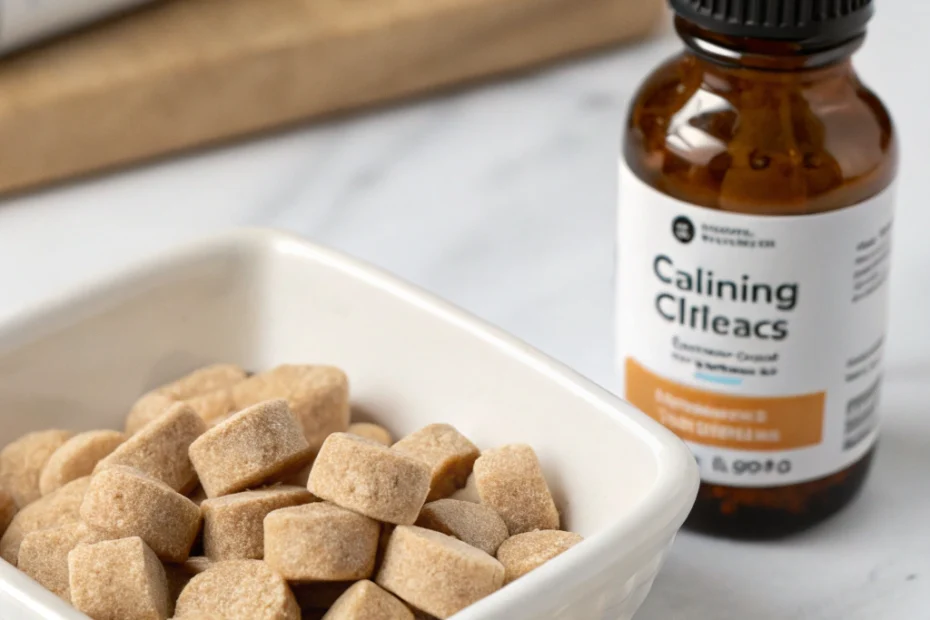At-a-Glance
Calming chews for cats are a popular option for pet owners looking to support their feline friends in managing stress and anxiety. These chews are part of the broader category of Cat Calming & Anxiety Relief Supplements and Products, which are designed to help cats feel more at ease in their environment. While they are not a cure-all, calming chews may help reduce anxiety symptoms in some cats, making them a valuable tool in your cat care toolkit.
How to Choose
When selecting calming chews for your cat, consider a few key factors to ensure you choose the right product. First, check the ingredients. Look for chews that contain natural ingredients commonly used for calming, such as chamomile, valerian root, or L-theanine. These ingredients are known for their soothing properties and are often found in calming products.
Next, consider the form and flavor of the chews. Cats can be picky eaters, so choosing a flavor your cat enjoys can make administering the chews easier. Additionally, check the texture and size of the chews to ensure they are suitable for your cat’s preferences and chewing ability.
Finally, read reviews and consult with your veterinarian. Reviews from other cat owners can provide insights into the effectiveness of the product, while your vet can offer personalized advice based on your cat’s specific needs and health conditions.
Safety & Setup
Safety is paramount when introducing any new supplement to your cat’s routine. Start by consulting with your veterinarian to ensure that calming chews are appropriate for your cat, especially if your cat has existing health issues or is on medication. Your vet can help you determine the best approach and monitor for any potential side effects.
When you first introduce calming chews, observe your cat closely for any adverse reactions. While these products are generally safe, some cats may experience mild digestive upset. If you notice any concerning symptoms, discontinue use and consult your vet immediately.
It’s also important to store the chews properly. Keep them in a cool, dry place out of reach of your cat to prevent accidental overconsumption.
Core Pillars
The core pillars of using calming chews effectively include understanding your cat’s behavior, creating a supportive environment, and maintaining consistency. Recognizing the signs of anxiety in your cat is crucial. Common signs include hiding, excessive grooming, or changes in appetite. By identifying these behaviors, you can better assess whether calming chews may be beneficial.
Creating a supportive environment involves providing safe spaces for your cat to retreat to when feeling stressed. This can be a quiet room, a cozy bed, or a designated area with familiar scents and toys.
Consistency is key when using calming chews. Administer them as directed and try to incorporate them into a routine. This helps your cat associate the chews with a sense of calm and predictability.
Placement & Environment Tips
Where and how you administer calming chews can influence their effectiveness. Offer the chews in a calm setting where your cat feels safe and relaxed. Avoid giving them during high-stress moments, such as during a thunderstorm or when guests arrive.
Consider pairing the chews with other calming strategies, such as playing soft music or using pheromone diffusers. These additional measures can enhance the calming effect and create a more soothing environment for your cat.
Ensure your cat has access to plenty of hiding spots and vertical spaces, like cat trees or shelves, where they can observe their surroundings from a safe distance.
Comparison with Alternatives
Calming chews are just one option among many for managing cat anxiety. Other alternatives include pheromone sprays, diffusers, and behavioral training. Each option has its pros and cons, and the best choice depends on your cat’s unique needs.
Pheromone products mimic natural cat pheromones and can create a calming effect in the environment. They are easy to use and can be effective for some cats, but may not work for all.
Behavioral training involves identifying triggers and gradually desensitizing your cat to them. This method requires time and patience but can lead to long-term improvements in your cat’s behavior.
Calming chews offer a convenient and often palatable option, but they may not address the root cause of anxiety. Combining chews with other strategies can provide a more comprehensive approach.
FAQs
Are calming chews safe for all cats? Most calming chews are safe for cats, but it’s essential to consult with your veterinarian before starting any new supplement, especially if your cat has health issues.
How long do calming chews take to work? The time it takes for calming chews to take effect can vary. Some cats may show signs of relaxation within 30 minutes, while others may take longer.
Can I give my cat calming chews every day? Follow the manufacturer’s guidelines and your vet’s advice regarding frequency. Some chews are designed for daily use, while others are intended for occasional use.
What should I do if my cat doesn’t like the chews? If your cat refuses the chews, try a different flavor or form. Alternatively, consider other calming products or strategies.
What to Do Next
Now that you have a better understanding of calming chews for cats, consider discussing this option with your veterinarian. They can provide personalized advice and help you determine if calming chews are suitable for your cat. Remember, managing your cat’s anxiety is a journey that may require a combination of strategies to achieve the best results.
Disclaimer: Always consult your veterinarian for personalized advice regarding your cat’s health.
